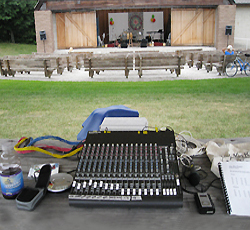
Remove the support act’s gear and set up again for the headline act. Do another line check to make sure nothing has changed.
No Soundcheck?
What to do If you have no sound check, say at a festival or “open mike” with short changeovers?
First, it helps to dedicate each snake channel and mixer channel to a specific instrument. Don’t change that assignment during the festival.
Suppose input 2 and snake channel 2 are always kick drum. The kick-drum settings that worked for band #1 might be in the ballpark for band #2. So when band #2 comes on stage, you’ll already have them roughly dialed in. Allow some extra channel assignments for larger groups.
Now, how can you get a quick monitor mix and house mix for the first band with no sound check?
At small festivals or open mics, you can set monitor levels ahead of time as you talk into each mic on stage. Listen to the monitors on stage and make sure they are loud enough and sound good.
As the band is setting up and you are placing the mics, ask them what they want in their monitors so you can pre-set that. Do a line check over headphones.
Even if an audience is present, see if you can set the monitor level quickly for each instrument and vocal before the band starts. The band members need to hear themselves clearly just to play, and you don’t want them to sound incompetent!
You’ll need to set up a mix quickly during the first song. Some engineers employ the following method.
Before the band plays:
1. Start with all the gain trims halfway up, maybe lower for condenser mics and loud instruments, higher for dynamic mics and vocals. Or set them based on your experiences at previous gigs (take notes). If you have a digital console, just recall a preset.
2. Set all faders down.
3. If you haven’t already set the monitor sends, turn them halfway up, or as the band requested during setup. Watch out for feedback.
4. Switch in high-pass filters and set them to a reasonable frequency for each instrument and vocal.
5. Set EQ either to flat or to “typical” values for each instrument and vocal.
6. Bring up the faders for the vocals or quiet instruments – slowly to prevent feedback. If there are no lead vocals, you might bring up all the faders equally.
When the band starts:
1. Touch up the mix.
2. If any channel is clipping, turn down its gain trim until clipping stops, and simultaneously turn up that channel’s monitor send by the same amount in dB.
3. Watch for the performers’ cues on stage, and touch up the monitor levels.
Some engineers prefer to set all the faders to design center (or up to 12 dB lower for large mixes), then mix with the gain trims.
Note: adjusting the gain trims will affect the monitor mix, making it similar to the house mix. Watch out for monitor feedback. The claimed advantage of this method is that it tends to create optimum gain staging in the mixer.
Good luck in running a professional sound check. The talent will thank you.
Bruce Bartlett has mixed sound for concerts, jazz festivals and folk festivals. Bruce and Jenny Bartlett are the authors of Practical Recording Techniques 5th Ed. and Recording Music On Location.
